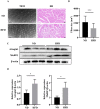A High-Fat Diet Induces Muscle Mitochondrial Dysfunction and Impairs Swimming Capacity in Zebrafish: A New Model of Sarcopenic Obesity
- PMID: 35565942
- PMCID: PMC9105418
- DOI: 10.3390/nu14091975
A High-Fat Diet Induces Muscle Mitochondrial Dysfunction and Impairs Swimming Capacity in Zebrafish: A New Model of Sarcopenic Obesity
Abstract
Obesity is a highly prevalent disease that can induce metabolic syndrome and is associated with a greater risk of muscular atrophy. Mitochondria play central roles in regulating the physiological metabolism of skeletal muscle; however, whether a decreased mitochondrial function is associated with impaired muscle function is unclear. In this study, we evaluated the effects of a high-fat diet on muscle mitochondrial function in a zebrafish model of sarcopenic obesity (SOB). In SOB zebrafish, a significant decrease in exercise capacity and skeletal muscle fiber cross-sectional area was detected, accompanied by high expression of the atrophy-related markers Atrogin-1 and muscle RING-finger protein-1. Zebrafish with SOB exhibited inhibition of mitochondrial biogenesis and fatty acid oxidation as well as disruption of mitochondrial fusion and fission in atrophic muscle. Thus, our findings showed that muscle atrophy was associated with SOB-induced mitochondrial dysfunction. Overall, these results showed that the SOB zebrafish model established in this study may provide new insights into the development of therapeutic strategies to manage mitochondria-related muscular atrophy.
Keywords: high-fat diet; mitochondria; muscle; sarcopenic obesity; zebrafish.
Conflict of interest statement
The authors declare no conflict of interest.
Figures





References
MeSH terms
LinkOut - more resources
Full Text Sources
Molecular Biology Databases
Research Materials

